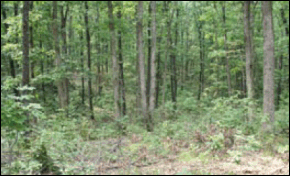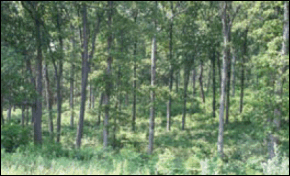Green Horizons
Volume 19, Number 1Winter 2015
TSI: Create healthy, vigorous stands
By Fred Crouse | Consulting Forester
Timber Stand Improvement (TSI) is a practice that foresters recommend to improve the forest stand, just as the name implies. This practice has often been compared to weeding a garden. A garden is usually full of unwanted plants (weeds) competing with the desired crop and it is the same with the timber. There are unwanted trees in the forest and these need to be removed.
The basic principle behind timber stand improvement is to remove/kill a certain number of trees or stems so that those remaining will have more room to expand their crown or top. Leaves drive the forest and with more foliage produced, energy production is increased which is turned into more wood and fruit production. Most of our oak stands are even-aged, meaning that the acorns germinated and sprouted to produce a seedling in about the same year, give or take a few. In an average oak stand there are 6-inch diameter trees and 11+inch diameter trees, all the same age. Most of the 6-inch trees have already been targeted by Mother Nature for removal from the stand and will die over the course of a few years.
A typical forest stand may have started with as many as 10,000 seedlings per acre. When the trees have finally matured in a century, that initial number of 10,000 will have been reduced to 75-100 trees. The TSI practice reduces that time frame to a few days with the help of a chainsaw or other equipment.
There are many reasons and benefits to thinning a forest stand and some of them are to improve the growth rate, forest health, species composition, ground cover, mast (fruit) production, economic value, aesthetics and so on.
From a timber stand point, the best trees (crop trees) should be left to grow. Squirrel, turkey, deer and other wildlife do not care what quality oak tree an acorn falls from as long as there are acorns for them to eat. A landowner should care whether that tree is a low quality pallet grade tree worth 7 cents per board-foot or a high quality veneer tree worth over a $1 per board-foot (a bd.-foot measures 12" x 12" x 1" thick). The low quality tree is taking up the same space and producing the same benefits, except for the dollars. Not all trees are going to be veneer grade trees but the best tree for a given spot should be left to grow.
A typical unthinned forest is growing at the rate of 20-40 annual rings per inch. This means that it is taking the tree 10-20 years to add an inch of diameter. With thinning, this is reduced to an average of four years per inch for oak. Red and black oak grow faster than white oak and can add as much as an inch of diameter every two years.
Wildlife benefit from TSI because the mast production is greatly increased for soft and hard mast trees. Soft mast tree species include mulberry, serviceberry, dogwood, persimmon and paw-paw. Hard mast tree species include the oaks, hickories and walnut. Other side benefits from TSI are an increase in ground cover which wildlife use for food, escape cover, and nesting sites. If spring color (flowers) or fall color is a goal, thinning improves tree vigor and creates a better show of color in the spring and fall.
Thinning or weeding the forest also helps the overall health of the forest. A healthy, vigorous growing tree is better able to withstand native pest and disease attacks or even prevents them from happening. Most native pests and diseases are opportunistic in that they usually attack a weakened tree. This does not apply to introduced insects and diseases like emerald ash borer, Dutch elm disease, chestnut blight and others which have invaded our shores. The impact of weather variations, too wet-too dry, can also be greatly reduced when the forest stand is vigorous and growing well.
If you are interested in improving your forest stands contact a forester. Contact information for foresters can be found in this issue of GH.
 |  |
Photo courtesy of Hank Stelzer |
|
Photo on left: before TSI. Photo on right: after TSI. |
|